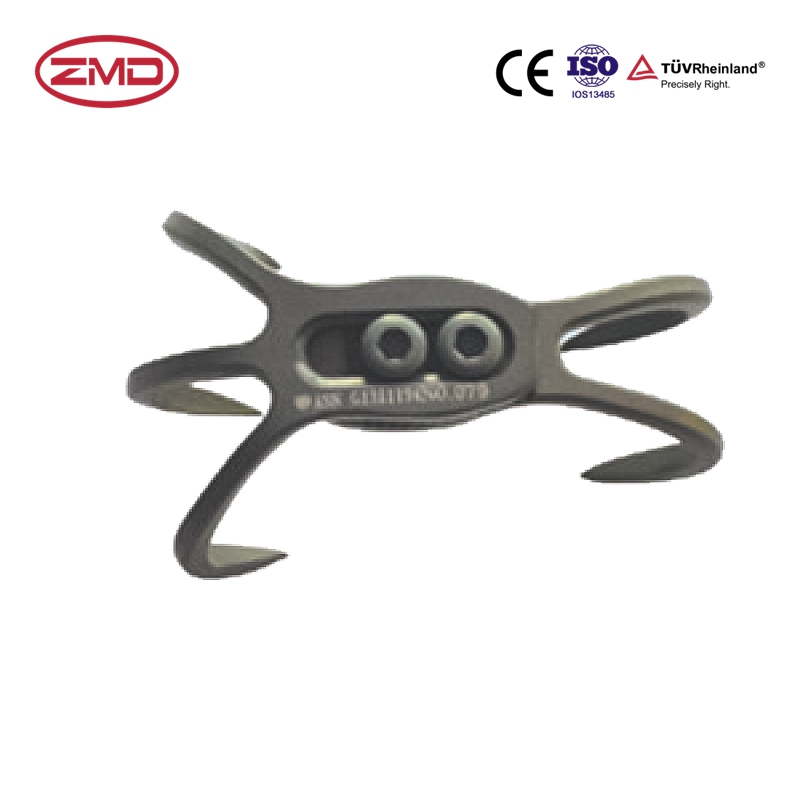
- Home
- About Us
- Products
- Trauma Internal Fixation System
- Spinal Internal Fixation System
- External Fixation
- Artificial Implants System
- Sports Medicine
- Power tools
- VSD System
- Instruments
- Medical supplies
- Blog
- Personnel Profile
- Contact Us
Phone line
1.Comprehensive Fixation for Complex Fractures: Designed for complex fractures involving both the ulna and olecranon, the plate offers comprehensive stabilization and promotes optimal healing.
2.Anatomically Contoured Design: The plate’s shape closely matches the contours of the ulna and olecranon, ensuring accurate fit and minimizing soft tissue irritation.
3.Secure Locking Mechanism: The combined locking feature provides robust fixation for both the ulna and olecranon fragments, preventing implant migration and promoting stability.
4.Versatility in Application: Suitable for a variety of fracture patterns, including comminuted and displaced fractures, offering flexibility to surgeons.
5.Improved Functional Outcomes: By restoring elbow stability and function, the plate contributes to enhanced patient quality of life and reduced pain.
| Code | Product name | Size | Related Screws |
| 4211.4503 | Ulna Olecranon Combinated Locking Plate | 3 Holes Left | 3.5mm |
| 4211.4505 | Ulna Olecranon Combinated Locking Plate | 5 Holes Left | 3.5mm |
| 4211.4507 | Ulna Olecranon Combinated Locking Plate | 7 Holes Left | 3.5mm |
| 4211.4509 | Ulna Olecranon Combinated Locking Plate | 9 Holes Left | 3.5mm |
| 4212.4503 | Ulna Olecranon Combinated Locking Plate | 3 Holes Right | 3.5mm |
| 4212.4505 | Ulna Olecranon Combinated Locking Plate | 5 Holes Right | 3.5mm |
| 4212.4507 | Ulna Olecranon Combinated Locking Plate | 7 Holes Right | 3.5mm |
| 4212.4509 | Ulna Olecranon Combinated Locking Plate | 9 Holes Right | 3.5mm |
Key features and benefits of the Ulna Olecranon Combinated Locking Plate
1.Enhanced Stability: The combined locking mechanism provides robust fixation for both bone fragments, promoting optimal healing and reducing the risk of implant failure.
2.Anatomical Fit: The plate’s contoured design ensures precise alignment with the ulna and olecranon, minimizing soft tissue irritation and maximizing stability.
3.Versatility: Suitable for a wide range of fracture patterns, including comminuted and displaced fractures, offering flexibility to surgeons.
4.Improved Function: By restoring stability to the elbow joint, the plate contributes to faster recovery, reduced pain, and improved range of motion.
5.Minimally Invasive Potential: The plate’s design may allow for less invasive surgical approaches, leading to smaller incisions and faster healing times.
Indications for Ulna Olecranon Combined Locking Plate
The Ulna Olecranon Combined Locking Plate is designed to address complex fractures involving both the ulna and olecranon bones. It is indicated for a variety of fracture patterns, including:
How does an Ulna Olecranon Combined Locking Plate Work
The Ulna Olecranon Combined Locking Plate is designed to provide stable fixation for complex fractures involving both the ulna and olecranon bones. The plate is strategically placed over the fracture site and secured in place using screws.
The locking mechanism of the plate is crucial for its function. The screws are designed to lock into place, preventing any movement or displacement of the plate and bone fragments. This creates a stable environment for bone healing and reduces the risk of implant failure.
The plate’s contour is designed to match the anatomy of the ulna and olecranon, ensuring optimal fit and minimizing soft tissue irritation. By providing a secure and stable foundation for the fractured bones, the Ulna Olecranon Combined Locking Plate helps restore elbow stability and function.
FAQ
Oh yeah! I have to mention their payment options and discount offers, which are awesome! Those payment methods are as flexible as moving water and can be chosen freely according to our cash flow situation. And the frequent discounts, like a timely rain, have been moisturizing our financial statements time and again, and have had a rocket-like positive impact on our profits! With ZMD, I feel relaxed and at ease when it comes to purchasing!
Send us a message if you have any questions or request a quote. Our experts will give you a reply within 24 hours and help you select the right valve you want.
Book Now
If you are looking for professional orthopedic medical product solutions, don’t hesitate to contact us now!

We are an integrated manufacturer specializing in orthopedic medical industry, providing high quality and reliable orthopedic medical products to customers worldwide.
Copyright © 2024 ASK Project